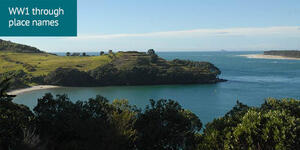
Anzac Bay, Bowentown. Credit: Sue Baker Wilson
Anzac Bay, Bowentown
This feature name resulted from several initiatives taken by local bodies. During a September 1915 meeting of the Katikati Domain Board, it was observed that the steep ascent from the beach at St George’s Bay closely resembled that at the bay on the Gallipoli Peninsula where Australian and New Zealand forces had landed on 25 April. The Board, therefore, proposed that St George’s Bay should be retitled Anzac Bay.
The Tauranga Harbour Board then took up this suggestion. Its members resolved that renaming the Bay after the Australian and New Zealand Army Corps would be a fitting ‘commemoration of our heroic boys and their fellow soldiers’. During November 1915, local dignitary George Vesey Stewart wrote to Tauranga MP William Herries requesting that the change be granted legislative approval.
In the event, it was decided not to wait for official permission. On 6 January 1916, a ceremony was held to ‘christen’ the Bay and open its new jetty and shelter shed, with both the Mayor of Tauranga and the Mayor of Waihi in attendance. Given that it took place only eight months after the original landings, this renaming was one of the first measures adopted in New Zealand to commemorate those who served at Gallipoli.
However, efforts at a governmental level ended in disappointment. Repeated entreaties from Stewart and Herries were turned down by the Lands Department, which refused to sanction the use of Anzac Bay on the grounds that a Māori name would be more appropriate. A further approach made to Prime Minister William Massey received a noncommittal reply.
References:
- Bay of Plenty Times, 6 November 1915, p. 4; 11 November 1915, p. 2; 8 January 1916, p. 2; 26 February 1916, p. 4; 12 June 1916, p. 2.
- New Zealand Geographic Board, ‘New Zealand Gazetteer’
Anzac Bay, Waiheke Island
The name of this feature commemorates the men and women of the Australian and New Zealand Army Corps. It was originally planned to call that unit the ‘Australasian Army Corps’, following the practice employed at several sporting events. However, soldiers of both nationalities were unwilling to surrender their separate identities. Although the exact origins of ‘ANZAC’ are unclear, it is widely believed that Sergeant K.M. Little, a headquarters clerk, developed the acronym after finding the full title too cumbersome to write down.
The Anzacs first saw action in 1915 when they played a significant role in Allied efforts to capture the Gallipoli Peninsula from Ottoman forces. By 1917, the re-organised I ANZAC Corps and II ANZAC Corps were both serving on the Western Front, while other ANZAC units were stationed in Egypt, Palestine, and Mesopotamia.
Anzac Bay appears on topographic map NZMS 260-S11, 1st edition, 1994, and on a survey plan, DP 73804, from 1974. Exactly when this name came into common use is unknown.
References:
- New Zealand Geographic Board, ‘New Zealand Gazetteer’
- NZ History, ‘ANZAC Day: The Anzacs’
Anzac Peaks, near Aoraki / Mount Cook
The English mountaineer Samuel Turner first scaled these two peaks on 6 February 1917. Despite achieving many notable feats during his career, including the first traverse of Aoraki/Mount Cook, Turner was a controversial figure. He was strongly disliked by many for his egotism and frequent attempts to downplay the efforts of other climbers.
The name Turner bestowed on these features was the ‘Anzacs’, which had become the common shorthand for referring to the men and women of the Australian and New Zealand Army Corps. It was originally planned to call that unit the ‘Australasian Army Corps’, following the practice employed at several sporting events. However, soldiers of both nationalities were unwilling to surrender their separate identities. Although the exact origins of ‘ANZAC’ are unclear, it is widely believed that Sergeant K.M. Little, a headquarters clerk, developed the acronym after finding the full title too cumbersome to write down.
The Anzacs first saw action in 1915, when they played a significant role in Allied efforts to capture the Gallipoli Peninsula from Ottoman forces. By 1917, the re-organised I ANZAC Corps and II ANZAC Corps were both serving on the Western Front, while other ANZAC units were stationed in Egypt, Palestine, and Mesopotamia.
Turner’s choice of the ‘Anzacs’ received initial sanction from the Ministry of Lands, but was quickly superseded by Anzac Peaks on most maps.
After an investigation, the New Zealand Geographic Board officially approved the name Anzac Peaks in 1947.
References:
- Honorary Geographic Board of New Zealand: Correspondence, vol. 1, pp. 38-43.
- Langton, Graham, ‘Samuel Turner: Climber and Egotist Supreme’, New Zealand Wilderness, May 2002, pp. 7-9.
- New Zealand Geographic Board: Minutes, 1947 (90).
- NZ History, ‘ANZAC Day: The Anzacs’,